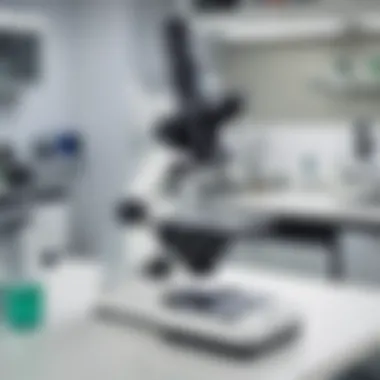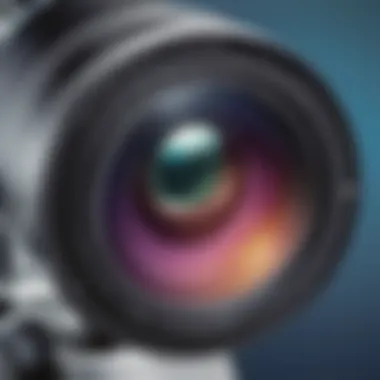The Ultimate Guide to Choosing a Veterinary Microscope


Intro
In the world of veterinary medicine, precision and clarity are crucial. A veterinary microscope serves as an indispensable tool in diagnosing animal health and studying biological samples. This guide aims to provide an in-depth look at the essential features and considerations when selecting the ideal microscope for animal care. Both beginners and seasoned professionals will gain insights into the types of microscopes available, the specifications that matter, and best practices for maintenance and use. With the right microscope, veterinarians can significantly improve diagnostic capabilities and enhance patient outcomes.
Science Fun Facts
- Did you know that the first microscope was invented in the late 16th century? It helped in revealing tiny creatures and details of life that were previously unseen.
- A microscope can make small objects appear 1,000 or even 1,500 times larger. This incredible magnification allows for detailed examination of cells, bacteria, and tissues.
- There are different types of microscopes including light microscopes, electron microscopes, and stereo microscopes. Each type serves a specific purpose in scientific inquiry or veterinary diagnostics.
Microscopes allow us to delve into a world that is invisible to the naked eye. They play a significant role in veterinary practices for accurate diagnosis and treatments.
Veterinary microscopes have unique features tailored to meet the demands of animal healthcare so knowing these specifics is important. This includes brightfield and darkfield illumination options that help visualize different types of specimens effectively.
In addition, images created with modern microscope technologies can even be captured using digital devices for further analysis.
Understanding such fascinating facts about microscopy not only aids in choosing the right equipment but also ignites curiosity in budding young scientists and veterinary professionals alike.
Future sections will discuss the diverse kinds of microscopes suited to veterinary practice and the critical specifications to focus on, enriching your journey in making informed choices that apply to real-world practices.
Prologue to Veterinary Microscopes
Veterinary microscopes play a pivotal role in animal health and diagnostic processes. Their importance cannot be overstated, especially in the field where accurate diagnoses are fundamental. In the next sections, we will dissect this crucial tool used by veterinary professionals, exploring its various aspects and its wider implications in healthcare for animals.
Understanding Veterinary Microscopes
Veterinary microscopes are specialized optical instruments designed for the examination of samples from animals. These samples may include tissue, blood, or skin samples. The microscopes amplify visual details of these samples, enabling veterinarians to detect diseases, parasites, and other medical conditions.
Each type of microscope—whether a compound or digital variant—serves distinct needs within the veterinary practice. Understanding the specifications and capabilities of these microscopes is essential for both effective diagnosis and treatment.
Features of veterinary microscopes often include objectives with different magnification levels and various types of illumination systems. The right combination enhances the physician's ability to see the finer details that matter in diagnosing animal ailments.
Importance of Microscopy in Veterinary Medicine
Microscopy holds immense importance in veterinary medicine, profoundly impacting diagnostic capabilities. Through detailed examination, professionals can often identify conditions that are invisible to the naked eye. For instance, parasites within blood samples or irregular cell formations in tissue can be key indicators of disease.
Moreover, by facilitating accurate diagnoses, microscopy not only aids in treatment but also helps in preventative health measures. In a broader sense, it plays a role in veterinary research where understanding disease mechanisms often begins with microscopic analysis.
In summary, veterinary microscopy enhances our insight into animal health, contributing toward more effective diagnostics and treatment strategies.
Ultimately, the ability to leverage the visual data provided by microscopy leads to informed healthcare decisions, thereby improving outcomes for animals. In the following sections, we will explore various types of veterinary microscopes available and the specific features to consider for effective use.
Types of Veterinary Microscopes
When considering veterinary microscopes, it is essential to understand the different types available. Each type serves specific purposes and has distinct advantages that cater to various veterinary applications. Knowledge of these types helps practitioners make informed decisions based on their unique needs and the demands of their environment.
Compound Microscopes
Compound microscopes are one of the most basic and commonly found types in veterinary settings. Designed for high magnification, these devices typically use multiple lenses to achieve clarity and detail. They are ideal for looking at thin specimens such as tissue samples or blood smears. Veterinary professionals often rely on French and German brands to ensure quality and reliability.
Benefits:
- High power magnification: Allows for seeing smaller details in specimens.
- Versatility: Perfect for different testing in veterinary medicine like microbiology.


However, there are considerations when choosing a compound microscope. One modifies the settings frequently, calibration is required for best performance. It's also important to balance quality with budget constraints.
Digital Microscopes
Digital microscopes have become increasingly popular due to their ability to provide real-time imaging and easy storage of data. These microscopes often connect to computers or mobile devices through USB or Wi-Fi. They allow for instant analysis and sharing capabilities, making them attractive options for tech-savvy veterinary practices.
Benefits:
- Easy documentation: Images and videos can be easily captured and archived.
- User-friendly: Many models offer simple interfaces for asisiting in customer showed aprendizaje.
Digital microscopes also present some integration challenges. Compatibility with various operating systems can affect usability. Practitioners might need basic technical support or training to fully leverage this technology.
Stereo Microscopes
Stereo microscopes, also known as dissecting microscopes, offer lower magnification and a three-dimensional view of the specimen. This is very useful in veterinary medicine for procedures requiring depth perception, such as surgical preparations or evaluating external parasites. They are ideal for observing live animals or detailed anatomical structures.
Benefits:
- 3D visuals: Enhances the ability to view structures in a more realistic way.
- Ease of use: Available models allow for quick viewing without extensive prep time.
Despite these advantages, stereo microscopes generally do not provide high enough magnification for detailed cellular studies, so they should be used in conjunction with other types of microscopes in professional settings.
Understanding these different types of veterinary microscopes ensures that practitioners choose tools that best fit their specific needs and practice. Whether focusing on diagnostic work or educational purposes, the right choice can significantly affect patient outcomes and enhance the quality of care provided.
Key Features to Consider
When selecting a veterinary microscope, there are several key features to consider. These factors not only influence the performance of the microscope but also determine how effectively it can be used in diagnosing and treating animal ailments.
Magnification Power
Magnification power is a critical aspect of any microscope, including those used in veterinary medicine. A microscope with adequate levels of magnification allows professionals to view small cellular structures and pathogens. Typically, veterinary microscopes come with varying magnification levels, often ranging from 40x to 1000x. Higher magnification can reveal details, such as the morphology of parasites or the structure of tissues.
Selecting a microscope with versatile magnification options can elevate your diagnostic capabilities. It's essential to choose a microscope that fits your specific needs, whether you are examining blood smears, skin scrapings, or histological slides of organ biopsies.
Optical Quality
The optical quality of a microscope directly affects the clarity and sharpness of the images produced. Poor optical quality can lead to distorted or unclear images, hindering the diagnostic process. It is crucial to look for high-quality lenses made of optical glass.
To assess optical quality, consider not only the materials used for the lenses but also the design. Aparature, contrast, and color fidelity should be optimal for detailed inspections. Professional veterinarians appreciate advanced optics that enable vivid and accurate representation of specimens. A microscope with superior optical quality is an indispensable tool when pinpointing subtleties in pathological samples.
Illumination Type
Proper illumination is vital for any microscopy. The type of illumination system integrated into a microscope determines how effectively samples can be viewed. There are several illumination systems commonly used:
- Brightfield illumination: Most common in laboratories, suitable for unstained slides.
- Darkfield illumination: Highlights light through specimens against a dark background, enhancing details often invisible in brightfield.
- Phase contrast illumination: Allows visualization of transparent samples without staining, which is beneficial for living cells.
- Fluorescence illumination: Used for specific staining techniques to visualize particular parts of the cells.
Understanding the different types of illumination and their applications will aid in choosing the right microscope. The illumination type can dramatically enhance confidence in diagnostics by rendering samples more visible.
Ergonomics and Design
The ergonomics and design of a microscope play a pivotal role in its usability and comfort during prolonged usage. A well-designed microscope minimizes strain on the user, enhancing both accuracy and efficiency. Key ergonomic features include:


- Adjustable height: Allows users to customize their viewing angle.
- Focus adjustment knobs: Smooth operation aids quick focusing without tiredness.
- Sturdy base: Ensures stability and reduces wobbling.
- Lightweight construction: Pixes usage to enable ease of movement and setup.
In addition to comfort, the design of controls should be intuitive. User-friendly interfaces and easy lens changes can significantly reduce time taken in clinical environments. When handling small swift animals, having reliable ergonomic machines supports prompt handling and manipulation.
Ensure you find a microscope that not only fits your technical requirements but also feels comfortable and natural to use.
Considering these key features can considerably influence the effectiveness and efficiency of veterinary practice. Choosing a microscope with well-thought-options supports a wide range of diagnostic and educational applications. By carefully evaluating these factors, veterinarians can enhance their diagnostic efforts and ensure better patient outcomes.
Recommended Veterinary Microscopes
Choosing the right veterinary microscope is crucial for effective diagnosis and treatment in animal healthcare. The various types that cater to the specific needs of veterinary medicine can make a significant difference in practice efficiency. Here, we will delve into recommended veterinary microscopes, examining key benefits and considerations that assist both novice users and experienced professionals in making informed choices.
Top Models Available
When exploring top models of veterinary microscopes, it is important to focus on the most reliable and efficient options on the market. Recognized brands which have built credibility in the field include Zeiss, Nikon, and Leica. These brands are noted for their optical accuracy, durability, and ease of use.
- Zeiss Primo Star: This compound microscope provides an excellent viewing experience with high magnification levels, suitable for various samples. Its illumination is designed for comprehensive visibility, aiding in the details of tissue sections.
- Nikon Eclipse Ti2: Another leading choice, this digital microscope comes with advanced imaging capabilities. It helps obtain high-resolution images, essential for research and diagnostic purposes.
- Leica MZ10 F: Ideal for studying larger samples, this stereo microscope allows for three-dimensional visualization, thus enhancing understanding of complex structures.
These models encompass a range of features that facilitate diagnostic success in veterinary practice.
Budget Options
For those operating under budget constraints, selecting a microscope that balances quality and affordability is vital. Some economical yet reliable options exist.
- AmScope 10: An entry-level budget microscope, great for beginners. Despite its lower cost, it offers decent optical performance and sufficient magnification.
- Omax 40x-1000x: This microscope combines affordability with decent functionality, making it suitable for routine examinations in veterinary clinics.
- Swift SW350T: Offers a good balance between price and features, including modern developments in LED illumination.
These budget options do not compromise essential functionalities while residing within a reasonable price range.
High-End Choices
Veterinary professionals looking for state-of-the-art features will likely prefer high-end models. Investing in a premium product can elevate diagnostic capabilities significantly.
- Olympus BX53: Known for its outstanding optical technology and advanced imaging options, useful in detailed examination processes.
- Leica DM4 B: This high-end model stands out for its automation capabilities. It enables seamless transitions between different examination needs, catering to specialized veterinary procedures.
- Nikon Eclipse NS2: It is engineered with multiple add-ons for more complex tasks, especially beneficial in high-standard research labs.
Overall, high-end models generally support intricate diagnostic applications, offering precision that conforms to rigorous veterinary standards.
Properly choosing a microscope not only increases efficiency but also enhances overall veterinary care standard.
Applications of Veterinary Microscopy
Veterinary microscopy plays a vital role in animal healthcare. A good microscope helps in the examination of biological samples. It allows veterinarians to diagnose diseases, understand health, and improve treatments. Each application emphasizes the importance of effective tools to enhance patient care.
Diagnostic Applications
Diagnostics is often the first step in any treatment plan. When an animal comes in with unusual symptoms, a microscope offers precise insights. Blood smears can reveal parasites or infections. Tissues from biopsies can show tumors or inflammatory conditions. All these microscopic examinations provide essential data.
Most veterinary microsopes also offer varied magnification. This feature allows a doctor to view both broad cellular structures and intricate details. Combining diagnostic methods with microscopy strengthens understanding of the animal's health status. Advanced techniques like cytology can assist in identifying ailments rapidly.
Research Purposes
Microscopy is not limited to clinics or hospitals. In research settings, it is crucial for advancing veterinary knowledge. Scientists study both animal diseases and broader ecological impacts. This research can lead to breakthroughs in treatment methods or preventive measures. Observations at the cellular level can provide this rich understanding.


Research often requires various types of microscopes. Researchers may use digital microscopes for exportable images. Or they may opt for fluorescence microscopes when working with specific samples. Each decision can depend highly on the research goal. Investing in the right microscope can amplify findings substantially.
Educational Use
Finally, veterinary microscopes serve an essential role in education. Schools and colleges need proper equipment to train future veterinarians. A good microscope allows students to directly engage with real-world samples. This collaboration can enhance efficacy in learning.
Working with microscopes introduces practical skills early in students. Moreover, it fosters a strong interest in veterinary science. Visual on an advanced scale appears through rigour in this educational link. Thus, preparing competent professionals for soft animal treatments.
Veterinary microscopy showcases how well tools can diagnose, research, and educate in animal care.
Understanding various applications ensures veterinary professionals get the best utilization. Each aspect highlights why selection in veterinary tools is significant.
Maintenance and Care
The performance and longevity of a veterinary microscope are directly linked to proper maintenance and care. Regular upkeep ensures that the instrument remains in peak condition, thus improving your ability to make accurate diagnoses. When well-maintained, microscopes provide clear images, preventing any hurdles in veterinary evaluations. Various aspects can factor into maintenance, including cleaning procedures and general care tips. Understanding these elements helps maximize the investment made in this essential tool for veterinary science.
Cleaning Procedures
Cleaning a veterinary microscope should be approached carefully to protector its parts from damage. Here are some critical steps to keep in mind:
- Use lint-free cloths: This minimizes the chances of scratches on lenses and surfaces.
- Avoid abrasive cleaners: These substances can ruin optical coatings. Many specialized cleaning solutions are available specifically for optical equipment.
- Microscope lenses should be cleaned regularly: Ideally, before every use. A few drops of lens cleaning fluid on a cloth made for optics will make for effective cleaning without damage.
- Manage debris on the stage: After every session, ensure any shavings or biospecimens end up being cleaned off. This action helps maintain the functionality of the mechanical stage.
In addition, be sure to follow the manufacturer's guidelines about cleaning. Failing to align with provided instructions can lead to unintended consequences related to warranty or functionality.
"One of the best preventative actions is regular cleaning and careful use of your veterinary microscope."
Regular Maintenance Tips
In addition to cleaning, several ongoing maintenance practices can prolong the life of your microscope. Some key tips include:
- Replace bulbs promptly: Old bulbs can cause negative effects on lighting quality and imaging clarity.
- Check adjustments regularly: Ensure that fine and coarse focus adjustments function smoothly.
- Inspect the stage: A well-functioning microscope stage ensures minimal wear and tear and makes specimen movement smooth.
- Calibrate the instruments: Regular checks on calibration hold importance as accuracy and reliability are crucial for diagnoses.
Focusing on these maintenance procedures will not only help to extend the lifespan of the microscope but also ensure the highest levels of accuracy in your exploratory endeavors. Dedication to proper care reflects professionalism and commitment to quality diagnosing in veterinary practices.
Finale
Choosing the right veterinary microscope is not just an exercise in spending finances. It is a matter of improving the quality of care provided to animals. The selection involves understanding specific requirements related to the types of diagnostics and the particular species of animals treated. An appropriate microscope can vastly enhance the precision in diagnosing ailments or conditions, ultimately benefiting patient outcomes and facilitating better treatment plans.
Making the Right Choice
When it comes to selecting a microscope, several factors play a role in making the best choice. First and foremost, clarity of optics is pivotal. Microscopes such as the Olympus BX-Series offer outstanding optical quality that eases the distinction of structures, which is crucial in a veterinary setting.
Furthermore, magnification power ranges should suit different evaluations. Some scenarios may only require a standard magnification of 100x, while others may need extremely high levels. For instance, veterinary pathologists often need higher magnifications found in digital microscopes.
Price cannot be disregarded. The choices range from budget-friendly microscopes like the AmScope Compound Microscope that serve novice practicioners to high-end models such as those from Leica Microsystems tailored towards research. Each budget dictates available options.
Ultimately, ergonomics must factor into the alignment of comfort and utility. Microscopes should fit comfortably in lab settings and accommodate different researchers. Look for good inherent designs in models like the Nikon Eclipse series to ensure a more accommodating user experience.
Future Trends in Veterinary Microscopy
The field of veterinary microscopy stands on the brink of several progressive trends. One of these is the increasing use of digital technology. Digital microscopes like the Zeiss Axio are rapidly attracting interest for their ability to output high-resolution images directly onto screens, facilitating easier sharing and analysis.
Another significant trend involves automation. Researchers now explore machine learning algorithms. Devices equipped with high-speed imaging capability are being developed to assist vets accelerate their diagnostic procedures. This marks a shift towards increased efficiency in laboratories.
Additionally, advancements in portable microscopy are set to showcase more accessibility. Instruments that connect with mobile devices allow veterinary practitioners to work in a field environment. The iRiS Smart Microscope, for example, illustrates this move well within the community.
The landscape of veterinary microscopy will continually evolve. Through understanding these features and trends, one can hope to support better health outcomes in animal care. With knowledgeable choices in tools, veterinarians can focus on what truly matters - the patients they serve.
“Investments in good quality veterinary microscopy pay off through better diagnostics and outcomes.







